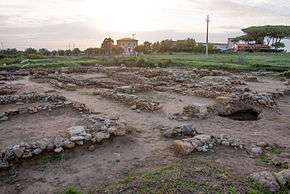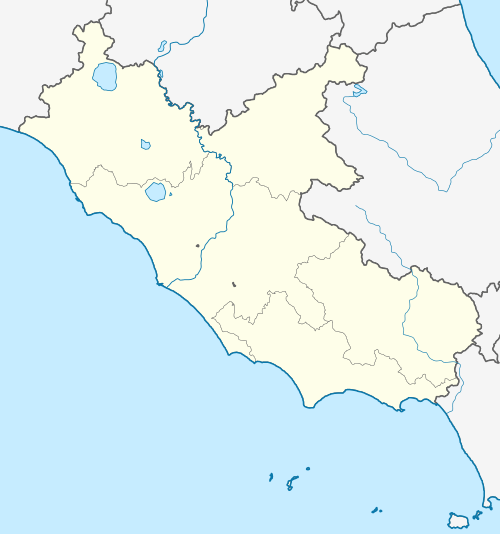Gravisca
| Graviscae | |
 The excavations at Gravisca, conducted by the University of Perugia. | |
 Shown within Lazio | |
| Region | Lazio |
|---|---|
| Type | Port, Settlement |
| History | |
| Periods | Orientalizing period - Roman empire |
| Cultures | Etruscan |
| Site notes | |
| Excavation dates | yes |
| Archaeologists | Mario Torelli |
| Condition | ruined |
| Public access | no |
Gravisca (or the Latin) Graviscae)[1] was the port of the Etruscan city of Tarquinii, situated 8 km west of the city center.[2]
The Etruscan settlement, occupied ca. sixth to third centuries B.C., had four principal occupational phases from ca. 600 to 250 B.C.[3] It was superseded by the establishment of a colonia of Roman citizenship at the site in 181 BC.[4] The port functioned as an emporion and there is ample evidence for merchants and perhaps Greek artisans based at the site.[5] The cults of numerous Greek gods, including Aphrodite, Hera,[6] Demeter, and Apollo, are attested
References
- ↑ Mario Torelli et al., “Gravisca,” NSc (1970)
- ↑ Denise Demetriou (22 November 2012). Negotiating Identity in the Ancient Mediterranean: The Archaic and Classical Greek Multiethnic Emporia. Cambridge University Press. pp. 83–. ISBN 978-1-107-01944-7.
- ↑ http://www.edipuglia.it/catalogo/collana.php?id=8 Gravisca. Scavi nel santuario greco
- ↑ Liv. 40.29.1.1 http://latin.packhum.org/loc/914/1/1526/45-53
- ↑ Benvenuto Frau (1981). Graviscae: il porto antico di Tarquinia e le sue fortificazioni. Gruppo Archeologico Romano.
- ↑ Mario Torelli "Il sanctuario di Hera a Gravisca” La Parola del Passato 136 (1971) 44-67.
Coordinates: 42°12′46″N 11°42′37″E / 42.21278°N 11.71028°E
This article is issued from Wikipedia - version of the 10/22/2016. The text is available under the Creative Commons Attribution/Share Alike but additional terms may apply for the media files.